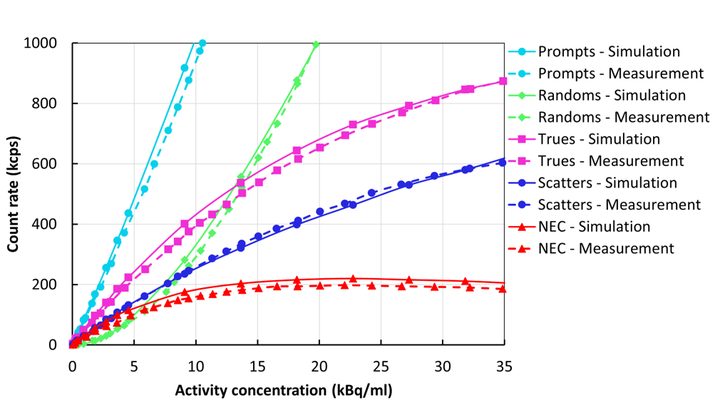Monte Carlo simulation of 4-ring Discovery MI PET/CT scanner and its extended axial field-of-view to 2 m
 Comparison of count rate curves: simulation vs measuremet
Comparison of count rate curves: simulation vs measuremet
Abstract
Objectives: There is growing interest in the development of total-body PET scanners. Two platforms have so-far been developed, the uEXPLORER and PennPET EXPLORER. The uEXPLORER is based on the United Imaging Healthcare’s uMI 550 and 780 SiPM PET/CT scanners, while the PennPET Explorer is based on the Philips SiPM technology used in the Vereos scanner. To our knowledge, investigation into the imaging properties of a hypothetical long AFOV GE Healthcare SiPM scanner based upon the Discovery MI system architecture has not been studied. The current GE Discovery MI scanner is available in 3, 4, and 5-rings (15, 20, and 25 cm AFOV). The aim of this work was (1) to develop and validate a Monte Carlo model of a 4-ring DMI scanner and (2) to extend its AFOV up to 2 m to evaluate its performance gain using standard NEMA measures.
Methods: The GE Discovery MI geometry and pulse digitization scheme were modeled within the GATE (Geant4 Application for Tomographic Emission) platform using published literature. Validation of the 4-ring GATE scanner model was performed by comparing published NEMA performance measurements [1] against the Monte Carlo simulations' results. The simulated scanner deadtime was heuristically tuned to match the experimental measurements. Following validation of the 4-ring model, the model was extended to simulate 20 ring (1 meter) and 40 ring (2 meter) systems. Spatial resolution, scanner sensitivity, Noise Equivalent Count Rate (NECR), and scatter fraction were characterized with slightly modified NEMA NU-2 2018 standards as described in [2]. NEMA count rates were estimated with an extended 175 cm long 20 cm diameter cylindrical scatter phantom with a 4 MBq 18F source for 4, 20, and 40-ring scanners. Relative gains in NECR were obtained by comparing peak NECR values. Additionally, the sensitivities were evaluated using NEMA methods, although with an extended 170 cm long line source.
Results: The average FWHM of the radial/tangential/axial spatial resolution reconstructed with filtered back-projection at 1 and 10 cm from the scanner center were 3.84/3.99/4.41 mm and 5.17/4.96/4.90 mm for the 4-ring scanner. NEMA sensitivity was measured as 15.39 cps/kBq at the center of the scanner FOV for the 4-ring scanner, and the scatter fraction at the NECR peak was 38.23%. Spatial resolution, sensitivity, and scatter fraction showed an agreement within 7.10%, 9.50%, and 4.15%, respectively, compared to published measured values [1]. The comparison of peak NECR with the standard 70 cm long NEMA scatter phantom in 4-ring scanner with 175 cm phantom in 40-ring scanner demonstrated a ~25× increase in NECR. The scanner with AFOV of 1 m resulted in a sensitivity gain of 8.5 times and for 2 m resulted in sensitivity gains of ~24-fold relative to the current Discovery MI 4-ring scanner.
Conclusions: Simulation of the 4-ring GE Discovery MI scanner was successfully validated, within measurement errors, against published NEMA performance data for all NEMA tests. Sensitivity and NECR performance of extended 1 and 2 meters AFOV scanners based upon the DMI architecture was subsequently simulated. Increases in sensitivity and count-rate performance are consistent with prior simulation studies utilizing extensions of the Siemens mCT architecture [3], and published NEMA measurements with the uEXPLORER system. The results of this work suggest a factor of substantial sensitivity enhancement when imaging patients on hypothetical 1 and 2 m long DMI scanner compared to a 4-ring 20 cm long DMI scanner. These performance enhancements are in-line with those measured on the uEXPLORER and PennPET EXPLORER platforms.